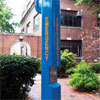
Broadcasting Security
University aims to grow capabilities and response with new system
- By Samuel Shanes
- Jan 01, 2012
The safety and security of
students, faculty and guests
is paramount for any educational
institution. It is always
a challenge to implement a
system that can not only protect
these people, but also
provide the means of responding
to any situation. Finding a
system that could easily tackle
these issues as well as
provide individual and mass
notification response was
critical for Shawn Woods,
director of security at the
University of the Sciences, in
Philadelphia.
“We wanted to look at a system that was
new, up-to-date and added additional features
that allowed for better two-way communication,”
Woods said. “We were able to address
multiple issues in regards to our emergency
notification and two-way communication. The
addition of the wide-area emergency broadcast
system contact platform allowed us to
implement a mass notification system into our
emergency process.”
The University of the Sciences recently
went through a dramatic overhaul of its security,
response and notification system. At the
core of this upgrade was an NFPA 72-2010,
Chapter 24 (ECS) compliant WEBS Contact
platform. The platform allows the university
to broadcast live and pre-recorded audio messages
to any exterior and interior paging units
and emergency phones strategically placed on
campus. At the same time, personal notifications
via SMS, e-mail or RSS can be routed to
the appropriate segments of the population.
Provided by Talk-A-Phone, the WEBS contact
platform offers a new way to combine
independent notification mediums into a
comprehensive crisis management solution.
In addition to personal notifications and
audio broadcasts to paging units, WEBS can
be integrated with high-power speaker arrays
and third-party paging systems. These combined
features are designed to make the job of
security staff easier during a crisis.
“The university is located on the west side
of Philadelphia and covers approximately five
square blocks,” Woods said. “The size of our
campus makes mass notification difficult. We
needed a way of contacting and providing
instructions to our students and staff in case
of an emergency. This platform allowed us to
do just that. It allows us to select the location
and means by which we contact our students
and faculty.”
During an emergency, confusion and slow
response time could be detrimental to an
institution’s response plan. Being able to provide
detailed instructions and information to
a specific location or group, at the push of a
button, can save security valuable time.
Unlike other mass notification systems,
WEBS Contact allows operators to segment a
population of any size geographically and
demographically, meeting NFPA 72-2010,
Chapter 24 (ECS) requirements.
“All managers have access to our mass notification
platform,” Woods said. “They have
the ability to remotely go into the system and
send out any message they like. These include
prerecorded messages covering events such as
an active shooter, fire, weather and lockdowns.
Our managers also can broadcast
unscripted messages to cover any situation we
may have.”
WEBS Contact allows security staff to create
location-specific pre-scripted emergency
notification profiles. In the event of a localized
emergency, such as a chemical spill,
security is able to execute a single notification
profile created for this specific event in a specific
location.
As part of the upgrade, the university also
has deployed WEBS emergency towers.
These highly visible emergency communications
towers feature an all-LED blue light at
the top and are capable of broadcasting
audio messages at a peak 123 dBA at one
meter. The sound pressure level can be individually
adjusted in each direction to accommodate
installation in the vicinity of residential
areas.
“Our supervisors especially like the ability
to use individual units in the system to broadcast
localized messages over the unit’s loudspeaker,”
Woods said. “For example, if we
have an incident at one of our resident halls,
one of our supervisors can use a special designated
key on a tower and broadcast instructions
using an internal microphone in the
unit. This is especially helpful for crowd control.
These features are everything we could
have imagined in a system.”
This article originally appeared in the January 2012 issue of Security Today.
About the Author
Samuel Shanes is the chairman of Talkaphone.